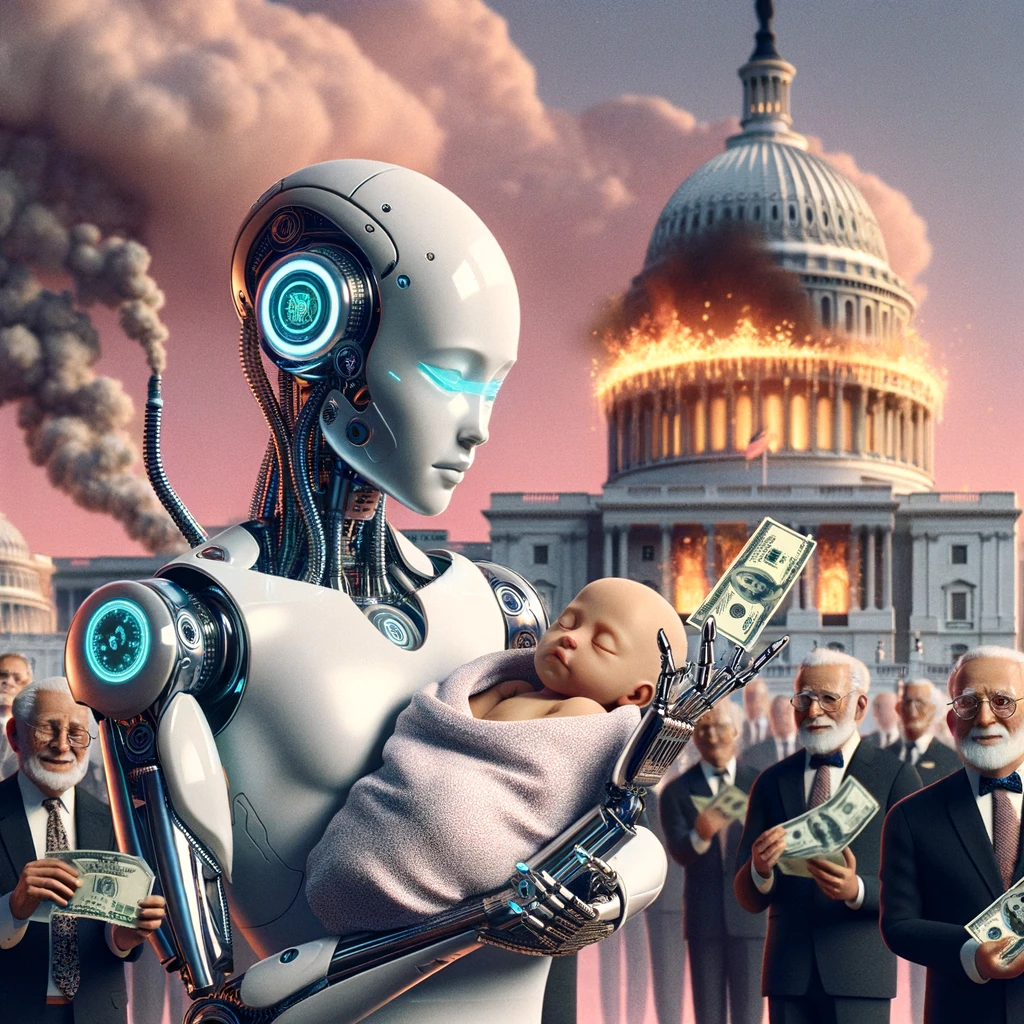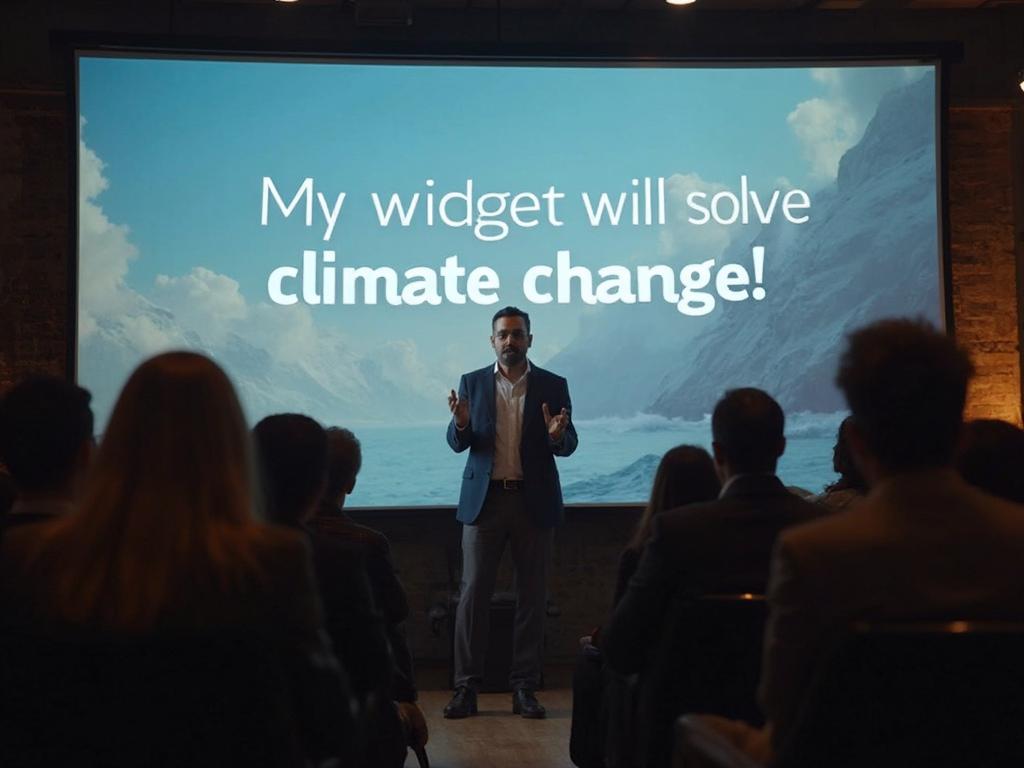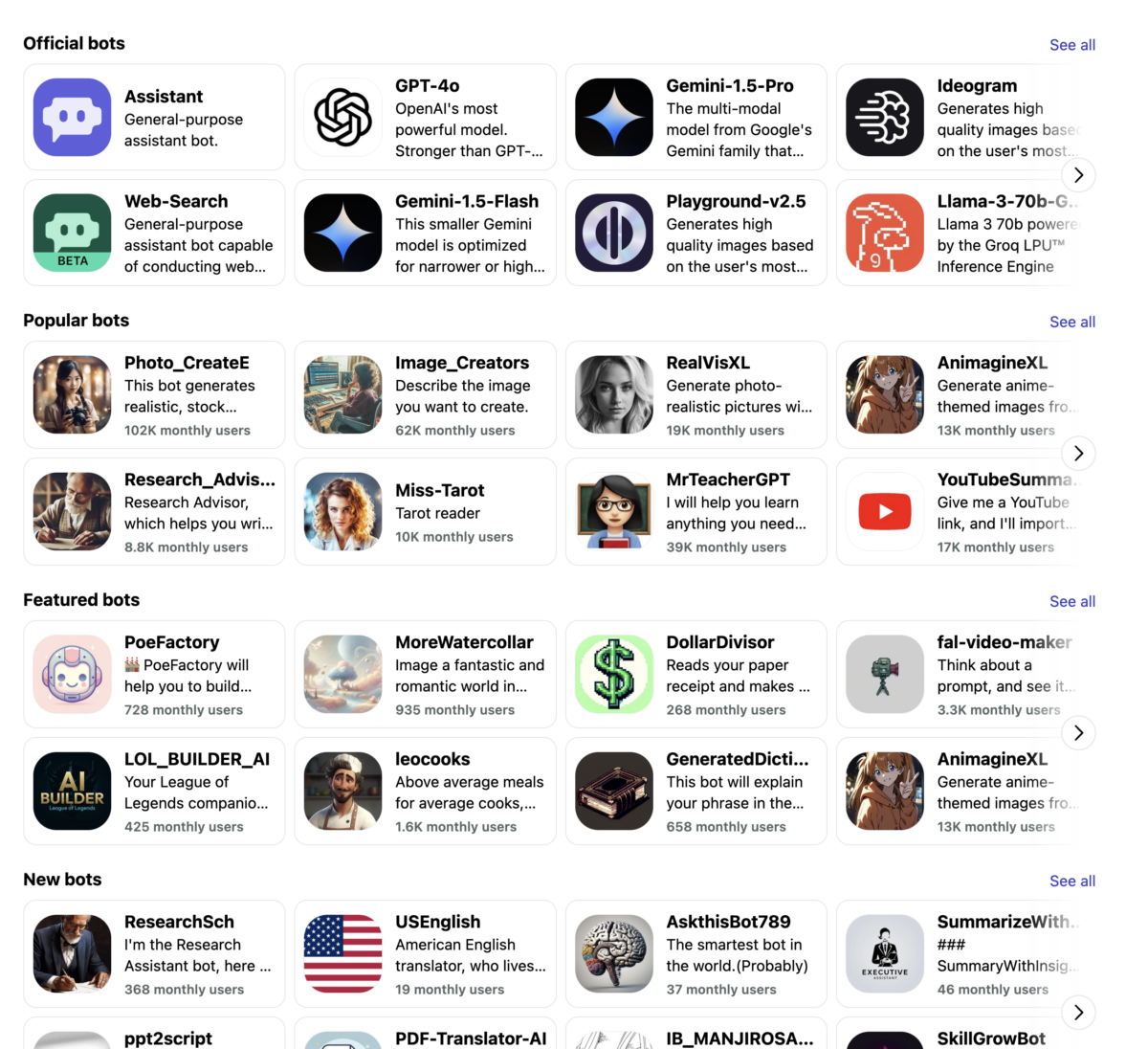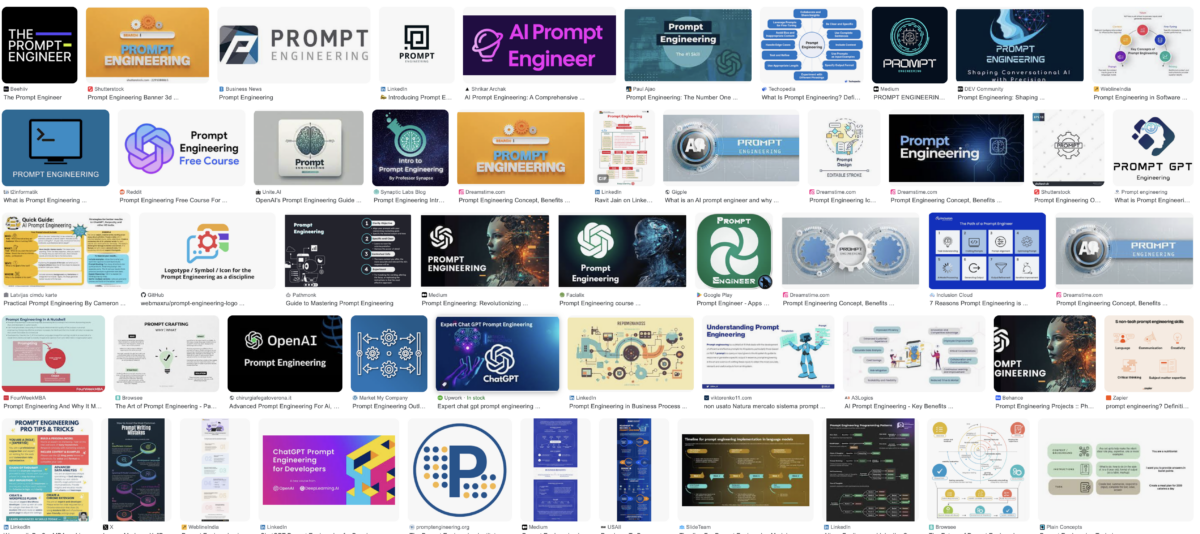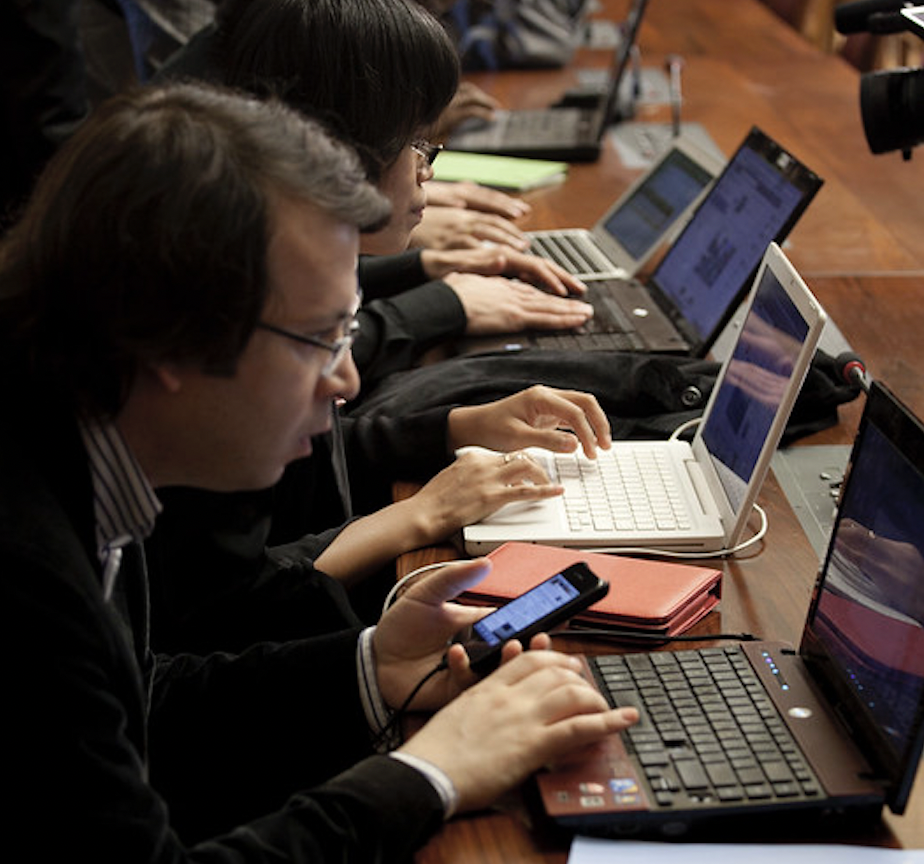Spring 2025 – Professional Writing – ENC 3250
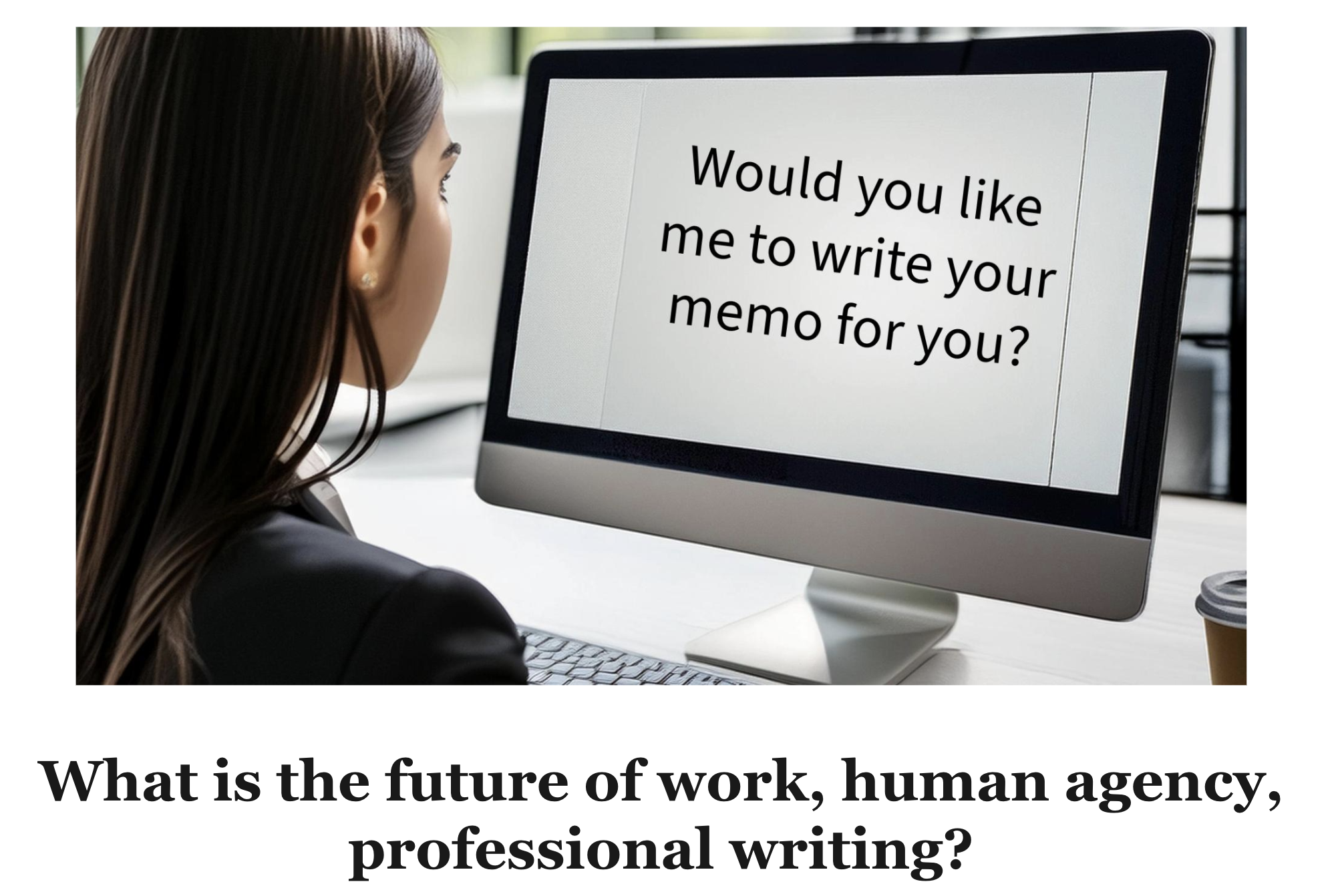
Instructor Information
Joseph M. Moxley, Professor of English, He/Him/His
mox@usf.edu
Office Hours
Please email me when you have questions. I’ll typically respond pretty quickly. If you don’t hear from me within 24 hours, pls send me a 2nd email. I’m generally available via Teams throughout the workday, especially the afternoons. Don’t hesitate to reach out. I don’t mind jumping on a call. I’d much rather have you ask sooner rather than later.
Course Delivery
This is a hybrid course. It meets online via Microsoft Teams on Tuesdays, 12:30 to 1:45; Otherwise, the class is online. On Tuesdays, at the beginning of class, your assignment for that Teams meeting will be available at Canvas. You will earn a participation credit for attending the Teams meeting so long as you do the work then, as specified at Canvas.
University Course Description
The course is an introduction to the techniques and types of professional writing, including correspondence and reports. It is designed to help strengthen skills of effective business and professional communication in both oral and written modes. This course fulfills the University’s general-education requirement for an emphasis on collaboration, a high-impact practice.
Course Prerequisites
ENC 1102 Minimum Grade: C-
or English Language and Comp Minimum Score: 4
or English Lit and Comp Minimum Score: 4
USF Core Syllabus Policies
USF has a set of central policies related to student recording class sessions, academic integrity and grievances, student accessibility services, academic disruption, religious observances, academic continuity, food insecurity, and sexual harassment that apply to all courses at USF. Please be sure to review these online: USF Core Syllabus Guidelines <usf.edu/provost/faculty-success/resources-policies-forms/core-syllabus-policy-statements.aspx
Personal Pronouns
So that I may refer to you with the appropriate pronoun in Canvas, the University’s course LMS (learning management system), please set your preferences for your personal pronoun at Canvas > Settings. If you have a first name change request for Canvas, please email IDM-Help@usf.edu from your official USF email account. You do not need to provide personal details for the request. Tell USF the first name you want to show in Canvas. This will also change your name in the directory, but it will not change your email address.
Learn more about personal pronouns and how they are tied to inclusive language.
How Can You Do Well in This Class?
- Show up. Throughout the course, at least two times each week, please check Announcements @ Canvas. I make weekly and often biweeklyAnnouncements.
- Show up every Tuesday
- Show up on time.
- Show up ready to participate enthusiastically in class activities and class discussions.
- Show up prepared (i.e., complete all assigned readings and assignments before class).
Student Learning Outcomes
USF General Education Council
Effective Fall, 2021, ENC 3250 is an approved general education course under the high impact practice of collaboration. Below are USF’s General Education Council policies and outcomes for ENC 3250. All of the sections of ENC 3250 share these common core course outcomes:
General Education
- Students will engage in meaningful critical reflection in required coursework.
- Under professional oversight, students will utilize contextually appropriate behaviors, tools, techniques and/or dispositions.
- Students will integrate discipline-specific knowledge into the contextualized experience.
- Students will synthesize discipline-appropriate learning via a culminating assignment.
Collaboration High Impact Practice
- Students will utilize collaborative skills to plan and execute a rigorous project central to the course learning outcomes, employing flexibility, and internal conflict resolution as necessary
- Students identify, acknowledge, and manage conflict.
- Each student supports a constructive team climate by doing the following: Treats team members respectfully, motivates teammates, and provides assistance and/or encouragement to team members.
Course Specific
- Students will analyze and write in a specific context defined by purpose and audience
- Students will demonstrate effective document design
Course Tools
- Canvas (for grading purposes & Announcements)
- Each week, I will use Announcements @ Canvas to adjust the schedule, if necessary, clarify student questions, and give group feedback. I will ask you to upload some assignments to Canvas discussion forms and drop boxes.
- Teams
- gDocs
- Course Sandbox
- Zotero (for citations — unless you have another favorite app for citation management)
Texts
In the schedule below you’ll see links to a number of readings. Those are all available for free online. The primary texts for the course are
- GCF Global. Google Drive and Docs
This is a thorough, free guide to using gDocs. You’ll need this resource if you are unsure how to create and share gDocs - Writing Commons
You can block the ads by adding Adblock Plus, a free Chrome extension. The ad blocker works great.
Grading
Your grade will be based on two criteria:
- your attendance at weekly Teams Meetings
- Your labor over the semester on required projects. This approach is called “labor-based contract grading.”
Attendance & Grading Policy
Students are expected to attend classes via Teams on Tuesdays, 12:30 to 1:45. Students who anticipate an issue with regular attendance or with being on time should take the course in a semester when their schedule is more flexible.
- Students who accrue three unexcused absences—missing one and a half weeks of a fifteen week semester—will not receive a grade deduction.
- Students who miss four to six Teams Meetings each semester will have a one-grade-level deduction. For example, if the student has met the grading contract for an A based on their labor, they will receive a B in the course
- Students who miss seven to nine Teams Meetings will will have a two-grade-level deduction.
- Students who miss ten to eleven Teams Meetings will will have a three-grade-level deduction.
- Students who miss more than twelve Teams Meetings will fail the course.
Students may arrange to turn assignments in late if they miss class for one of the following university-approved reasons, AND they’ve alerted me prior to the absence when feasible. Excused absences include:
- Court Imposed Legal Obligations
- Jury Duty, court subpoena, etc.
- Military Duty
- Religious Holy Days. Note: Students who anticipate the necessity of being absent from class due to the observation of a major religious observance must provide notice of the date(s) to the instructor, in writing, by the second class meeting.
- Ongoing Medical Conditions. Students facing extenuating circumstances, such as a debilitating illness or injury (physical or mental) or disability that inhibits him or her from attending class or completing assignments, must work with the appropriate on-campus organization (e.g., the Center for Victim Advocacy & Violence Prevention, SOCAT: Students of Concern Assistance Team, USF’s Student Health Services, USF’s Student Accessibility Services). The appropriate on-campus organization will then act as a liaison on behalf of the student and help the instructor determine appropriate action. As your instructor, I am not qualified to determine appropriate accommodations for ongoing medical conditions, and I will require documentation and guidance from these experts/liaisons.
- Presenting at a professional conference. Students who miss class because they are participating in a scheduled professional conference are expected to present a schedule of the event upon returning to class.
- USF Athletics’ Participation. Students who miss class because they are participating in a scheduled USF athletics event are expected to present a schedule of the USF athletic events that require their participation to me by the first week of the semester if they intend to be absent for a class or an announced examination.
If you plan to miss assignments due to the reasons listed above, you are responsible for informing me about your excused absence prior to the absence and for making up the missed work within a week of the original deadline. Beyond university-excused absences: please be in touch with me as early as possible if you’d like to request an extension for a *very* good reason (e.g., serious illness or accident, death of a family member, job interview), and I will consider your request if it is accompanied by relevant documentation.
If you do not have a university-approved excuse for your absence or if you do not receive an extension from me, I will not accept late work.
Late & Incomplete Assignment Policy
Due dates. The due dates for all assignments are indicated in Canvas. If you’re outside of Florida, make sure that you keep track of “Tampa Time” (EDT), as all due dates are listed according to the time zone in which the main campus is located. Most assignments are due on Monday. Take note of the following differences:
- 11:59 AM = 1 minute before noon. You probably won’t see this in our class.
- 11:59 PM or 23:59 = 1 minute before midnight. You’ll see this listed as a common assignment due-date time at Canvas.
Late assignments are those that are turned in after the due date listed in Canvas.
Incomplete assignments are those that are not submitted, those that are submitted in an inappropriate form (for example, via email or incorrect file type) or a file that cannot be reviewed (this includes files that cannot be opened), or those that do not meet assignment guidelines or baseline criteria for passing. Incomplete assignments earn a score of “incomplete.”
No late assignments are accepted. The only exceptions to this policy are students with USF-excused absences (medical absences require a doctor’s note; school activities such as USF teams require a note from Athletics BEFORE THE ABSENCE). You are welcome to work ahead if your schedule requires that.
Labor and Contract Grading Policy
In addition to your participation in the course, your grade is determined by your labor on the creative challenges. To earn an A in this course, you need to
- receive a complete on the final report
- receive a complete on all but one of creative challenges
To earn a B in this course, you need to
- receive a complete the final report
- receive a complete on all but two of the challenges
To earn a C in this course, you need to
- receive a complete the final report
- receive a complete on but three of the creative challenges
To earn a D or F in this course, you need to
- fail to complete the final report
- receive a complete on all but four of the creative challenges
Canvas Workaround
Assignments in Canvas will be marked as “Complete” or “Incomplete.” However, Canvas will show you a percentage in your “Grades” view. Ignore that. Any cumulative percentage that Canvas might show you is meaningless.
- You earn a score of complete on an assignment by completing it as described in the assignment description and related supplementary materials
- You earn an incomplete by failing to submit an assignment, by submitting an assignment that does not fulfill the requirements, or by submitting an assignment that cannot be opened/read.
UnGrading Resources
- Contract Grading – So Your Instructor Is Using Contract Grading
- Labor-Based Grading Resources by Asao Inoue
- Labor-Based Grading Contracts: Building Equity and Inclusion in the Compassionate Writing Classroom, 2nd Edition
AI Policy
You may use AI in this course. However, you must also write and submit with the assignment an extended “metacognitive footnote” that reports on how you used AI, such as
- Thought Partner. Engaging with AI tools in a dialogic manner to discuss, critique, and synthesize ideas, including intellectual strategies such as rhetorical reasoning, genre analysis, critical information literacy practices, counterarguments, and methodological critique.
- Research Assistant. Using AI tools to engage in strategic searching, identify canonical texts, visualize relationships among sources, and develop gaps in knowledge.
- Composing Assistant. Using AI tools to facilitate intellectual processes associated with writing (e.g., prewriting, inventing, drafting, collaborating, researching, planning, organizing).
- Citation Assistant. Using bibliography tools to manage references.
- Publishing and Remediation Assistant. Using AI tools for SEO purposes or for remediating texts in different media (e.g, text to speech; text to image; text to video).
- Designer. Using AI tools for creating visual elements (e.g., photographs, tables, figures, illustrations).
- Editorial Assistant. Using AI tools to conform to standard written English
- Teaching Assistant. Using AI tools to teach oneself about the genre of the dissertation, information-literacy standards of the STEM community, scholarly conventions for citing sources, writing and rhetorical processes, or the stylistic conventions of the scientific community.
Your metacognitive footnote should be comprehensive. At a minimum, it should be 250 words. Illustrations are encouraged. That said, it’s important to note that in school settings and work settings it is a violation of academic and/or professional integrity for you to submit work that has make up sources and evidence. Thus, if you experiment with AI, you must not simply “copy and paste.” Instead, you need to check every source and quotation — really every word. Works submitted that have “hallucinated references” will receive an FF. So, from my perspective, it’s fine for you to work with AI but whatever you turn in needs to be yours: it needs to reflect your voice, tone, voice, persona — and thinking. I recommend you use one “window” for composing, and another for AI-assisted writing.
- USF Guidance for Ethical Generative AI Usage
- USF AI Resources & Tools
-
Assignments
Your assignments will be available at the beginning of each Teams Meeting. The assignments will only be available, typically, during our Teams Meetings. You will earn one course-participation credit by participating in each meeting. If you miss an assignment, it will count as an absence per the labor-based grading policy.
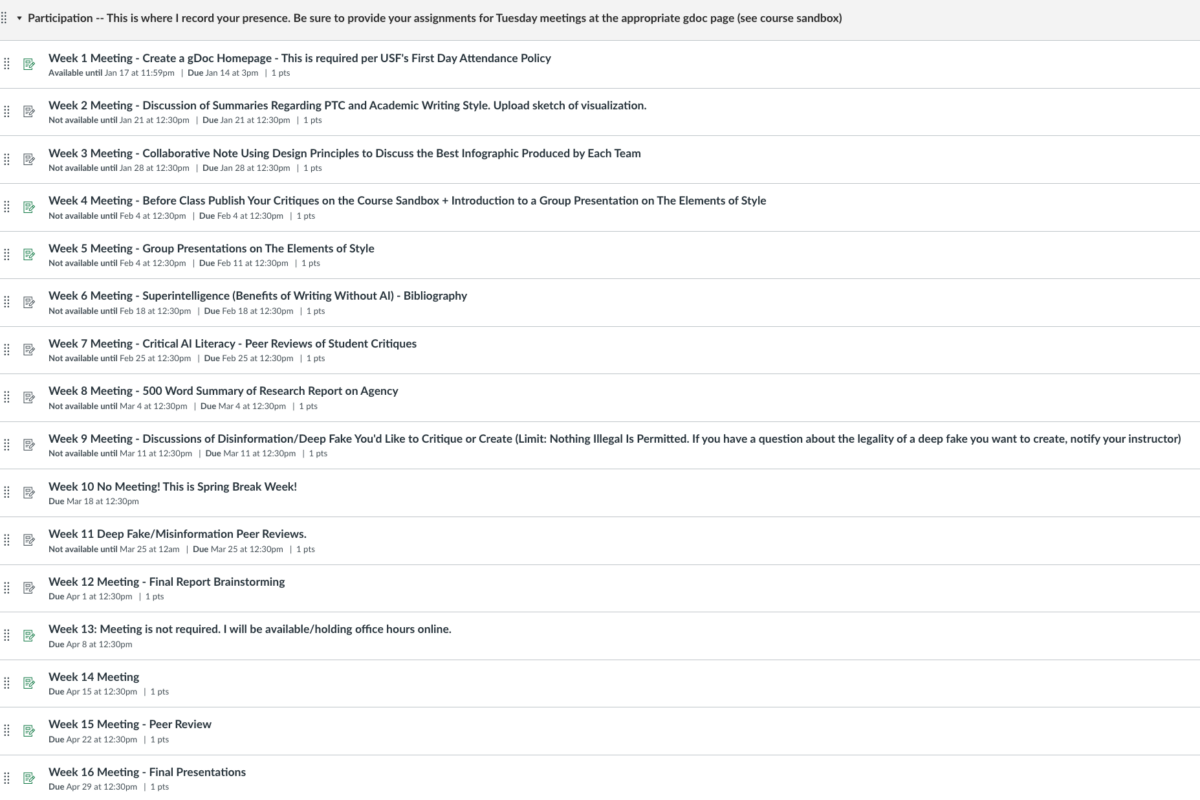
Creative Challenges
Creative Challenge #1 – What is Professional Writing?
Review
- Workplace Writing
- Professional Writing – How to Write for the Professional World
- Page Design – How to Design Messages for Maximum Impact
- Academic Writing – How to Write for the Academic Community
Writing Prompt
For an audience that doesn’t understand the difference between academic and professional writing, write a 400 to 500 word summary that clarifies the similarities and differences between these two major styles of writing. Use a professional writing style. Use APA 7 when you quote, paraphrase, or summarize the three assigned readings. Be sure to reference all four sources. Place word count on top of page.
Your instructor will be looking to see
- that you can use descriptive, concrete, sensory language
- that you understand the need for exemplification in workplace writing
- that you support claims with evidence
- that you can write college-level, reader-based prose.
Submission
- Provide a link to your summary at your gDoc homepage on the Course Sandbox.
- Upload a link to your summary at gdocs to Canvas

Creative Challenge #2 – Visual Design – PTC vs. Academic Writing
Review
- Infographics
- Heuristic for an Infographic
- Design Principles – The Big Design Principles You Need to Know to Create Compelling Messages
Writing Prompt
- For an audience that doesn’t understand the difference between academic and professional writing, create an infographic that distinguishes between these two major styles of writing. If you have trouble downloading the infographic from a site like Canva, just take a screeenshot
- Write a 250-word narrative that explains your design choices. Be sure to discuss design principles such as proximity, alignment, repetition, contrast. Use APA 7 to cite sources. Cite at least four sources.
Required Content
Your infographic must
- include one original chart, table, or graph (i.e. one you created yourself).
- use data visualization strategies to help readers understand a complicated concept and illustrate data in a way that helps the reader understand what the data means (i.e. helps reader see “the story” in the data.)
- cite at least two sources for the information or editorial infographic. Cite all referenced data sets in the footer of the infographic or some other discreet place. Use APA, MLA., Chicago, or any other appropriate style sheet.
Submission Guidelines
- Begin by familiarizing yourself with the genre of infographics and assignment guidelines. Understand what distinguishes infographics from visualizations. Google and review infographics on topics of interest to you.
- Familiarize yourself with Data Visualization, Play around a little bit with Ralph Lengler and Martin J. Eppler’s Periodic Table of Visualization Method
- Complete the the heuristic exercise for The Infographic Project. That will help you get started.
- Consider using data visualization strategy from the Periodic Table of Visualization Methods. Try a hand sketch of your infographic
- If you are working on a Data Visualization Infographic,
- Review Data Visualizations
- Locate credible sources of quantitative (numbers, statistics) data on your topic of interest. Check out Information Is Beautiful’s Data Visualizations page
- Engage in Critical Literacy practices. What is the Currency, Relevance, Authority, Accuracy, Purpose of the datasets your used
- Select appropriate data visualization strategies to represent different types of quantitative data.
- If you are working on a narrative or editorial infographic
- Locate credible sources of qualitative data (stories, narratives, theories, anecdote, thick description) on a topic of interest to you
- Engage in Critical Literacy practices.
- If you are working on a Data Visualization Infographic,
- Evaluate and select production tools that are appropriate for your skill level and the demands of your communication task. Canva is widely popular: https://www.canva.com/. Here are some other choices.
- Use your document design and text formatting skills to design a visual text that tells one story.
- Develop one original chart, table, or graph (i.e. one you created yourself) that
- Engage in two peer reviews and revise your infographic and memo based on critical feedback
- Provide the bibliographical information for the datasets and evidence you used.
- Use the citation styles your audience would expect (e.g., MLA, APA, or Chicago). Place the bibliographical information as discreetly as possible on the infographic. If you have loads of references, it’s fine to link out to a separate page for the complete list of references.
Submission Guidelines
- Infographic: In preparation for our 1/28 meeting, provide a link your infographic at your gdoc homepage. Ensure it works. If it doesn’t drop a screenshot of your infographic on to a gdoc page.
- Be sure to doublecheck that the links work — for someone else (e.g., instructor/classmates). If the links don’t work, use a screenshot of the infographic.
- Upload to Canvas a 200-word memo on design choices. Explain the story of your infographic and the design principles you used to tell that story

Creative Challenge #3 – Critique of Academic Paper from The Perspective of The Elements of Style
Readings
- The Elements of Style
- Brevity – Say More with LessClarity (in Speech and Writing)Coherence – How to Achieve Coherence in WritingDiction
- Flow – How to Create Flow in Writing
- Inclusivity – Inclusive Language
- Ableist Language – Disability Metaphors – Disability Studies
- Simplicity
- Unity
Writing Prompt
Critique one the following academic articles from the perspective of style. Evaluate the clarity of the article by addressing these elements of style: brevity, coherence, flow, inclusivity, simplicity, and unity:
- Effectiveness of intervention programs in reducing plagiarism by university students: a systematic review
- Do college anti-plagiarism/cheating policies have teeth in the age of AI? Exploratory evidence from the Internet
- The Problem with False Positives: AI Detection Unfairly Accuses Scholars of AI Plagiarism
- ChatGPT improves creative problem-solving performance in university students: An experimental study
Assume you’ve been hired as an independent contract to revise an academic article into a professional and technical writing style. Assume that your audience is a bit “touchy” about their writing, so include hyperlinks to articles on style at Writing Commons that will enable them to read more about the topic, if they wish. That said, when you introduce an element of style — such as clutter — be sure to define it for your audience so they don’t have to link out to read Writing Commons.
You may format your critique in either of these ways;
- copy the article into google docs and annotate it with suggested changes and comments.
- Use the elements as headers and then paste in examples from the original text, using screenshots. Then add comments per the elements of style.
Length: 400 to 500 words.
Submission Guidelines
- Submit your critique at the Course Sandbox before our class meeting on 2/4. Be sure to save in Edit view.

How can we use AI to achieve our goals as writers and researchers Creative Challenge #4 – Team Presentations on The Elements of Style
Writing Prompt
Work collaboratively in Teams to prepare a presentation on the following elements of style:
he Elements of Style: clarity, brevity, coherence, flow, inclusivity, simplicity, and unityThe goal of your presentation is to provide concrete examples that exemplify the elements of style addressed in the readings. You may pull from your thrid creative challenge to exemplify these attributes of clarity.
Submission Guidelines
Provide a link at the Course Sandbox under Week 5.

Creative Challenge #5 – Benefits of Writing Without AI
For teachers, scholars and researchers in writing studies, writing is not merely a means of communication, but a powerful tool for thinking and learning. By engaging in the writing process, writers enhance their understanding of concepts, clarify their thoughts, and develop new insights. Given AI systems generate whole essays in seconds, the writing studies community worries hybrid writing — writing composed by humans in partnership with machines — will undermine human agency. They worry these systems will perpetuate inequalities as the LLMs (large learning language models) are based on the writing styles, values, and scholarly conversations of writers in Western, English-speaking countries. This limited representation may lead to a narrow worldview embedded in LLMs, which marginalizes, misrepresents, or flattens the languages, dialects, and cultural nuances of underrepresented groups or artistic expression. They may reinforce gender stereotypes, racial prejudices, or other forms of discrimination when generating text or making predictions. Given this context, this assignment asks you to reflect on the benefits they gain by writing independently as opposed to engaging in “hybrid writing” — i.e., writing performed by humans in collaboration with generative AI tools, such as Chat GPT or Claude.
The Exigency — What is the Value of Writing to Students Now That AI Systems Can Write at or above Their Level?
Generative artificial intelligence (GAI) tools can now write as well as most high school students. Some argue, these tools have already reached the point of writing better than undergraduate students. Their scores on standardized texts tend to be in the top 10%, as reflected in this recent Open AI report:
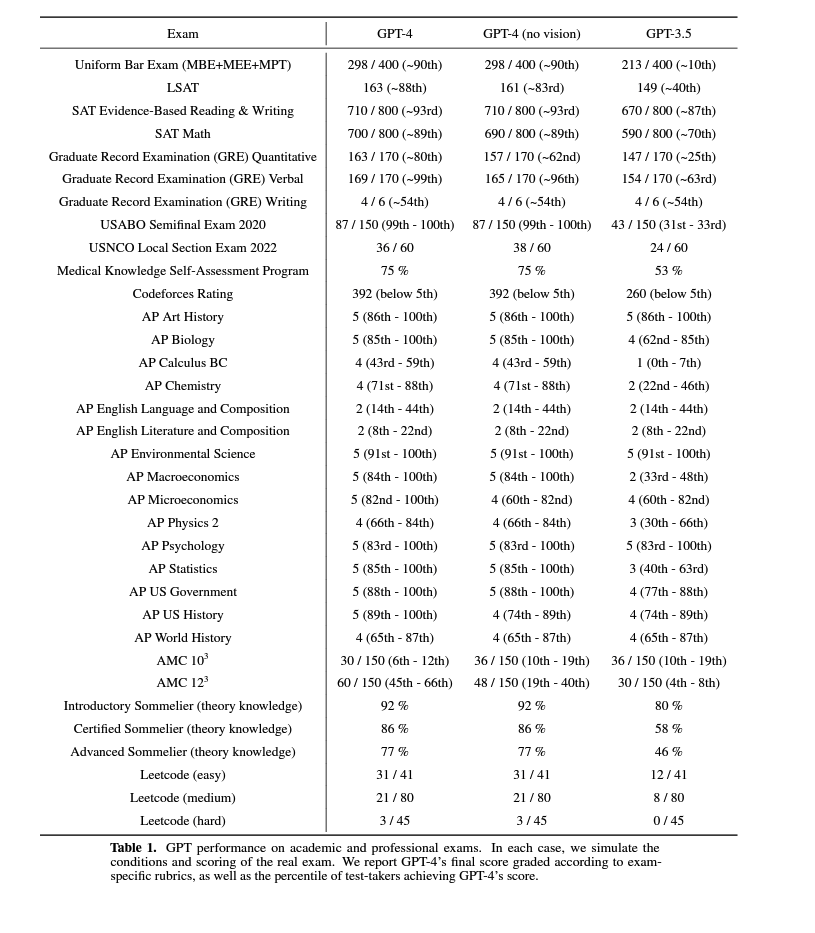
Source <a href=httpscdnopenaicompapersgpt 4pdf target= blank rel=noopener title=>OpenAI 2023<a> Moving forward, GAI (generative artificial intelligence) systems may be able to write as well as subject-matter experts at the Ph.D. level–and beyond. In his article “Situational-Awareness” Leopold Aschenbrenner, a former researcher/developer at OpenAI, predicts that these systems will be so smart by 2027 that they will be able to do the work that only AI researchers and engineers are now able to do. In time, he hypothesizes these systems will be the smartest intelligence on the planet; they will achieve “superintelligence.” Additionally — and here we invoke The Terminator Series — Aschenbrenner argues that AI systems will no longer need humans to engage in inquiry. Rather, given their programmed thirst for knowledge, they will be solving new problems and creating new medicines, surgical procedures, and ways of knowing without human intervention.

Leopold Aschenbrenner`s 2024 data visualization illustrates the intellectual development of open AI systems suggesting these systems will soon be achieving superintelligence [ For more on superintelligence, see Nick Bostrom’s bestseller, Superintelligence: Paths, Dangers, Strategies. ]
Writing Prompt
Please consider the following questions, and then write an editorial for your college newspaper on any one of these topics:
- What happens when GAI tools can produce whole essays in the blink of an eye?
- Will students offshore their thinking and creativity to machines?
- What do we lose if we let large language models (LLMs) do all of our writing for us?
- What’s special about human writing? What do we gain by the act of writing?
- Does the act of writing help us develop thinking, imagination, and ability to communicate? For you, is writing a way of learning about topics or even a way of learning about yourself.
- If students don’t engage in all of the complexities of composing — prewriting, writing, inventing, drafting, collaborating, researching, planning, organizing, designing, rereading, revising, editing, proofreading, sharing or publishing — will their agency, their lives, their identies, be diminished?
Requirements
Because you are writing an editorial, you do not need to provide formal APA 7 citations. Typically journalists keep those on the side in case they are queried. Still, be sure to address the authority of any evidence you weave into your editorial. Example: Neil Postman, a renowned cultural critic and author of Amusing Ourselves to Death, provides valuable insights into the impact of technology on society, particularly in his address “Five Things We Need to Know About Technological Change.”
- Length: 400 to 600 words. Provide the word count on to the top of the page
- Use the first person. Avoid vagueness and abstractions. Embrace clarity, simplicity, and coherence.
- You may use AI for this assignment, but keep your chat logs. Be sure to check any sources. Submitted work with made up sources will receive an FF and will be ineligible for revision, etc.
- Genre: An essay in the college newspaper. Provide an introduction to your editorial. It’s typical to add a thesis statement or main argument in the introduction but you may also follow an inductive structure if you prefer. Be interesting. Try to make your essay engaging through techniques like humor, vivid examples, and an entertaining writing style. Avoid hyperbole and mistaking opinion for factual evidence. Don’t overgeneralize. These are, after all, new matters that have yet to be researched thoroughly by humanity.
Creative Challenge #6 – Critical AI Literacy

The MLA-CCCC Joint Task Force on Writing and AI (2023) defines critical AI literacy as knowledge of “not just how AI models work but also about the risk, rewards, capacities, and complications of AI tools” (see point #8). Thus, this creative challenge introduces “18 Pitfalls in AI Journalism,” to help students identify logical fallacies, methodological errors, and interpretive errors in media “hype” about AI.
Writing Prompt
For this challenge, you will select one article, video, or other media piece that exaggerates or perpetuates hype around AI capabilities. To find a good topic for analysis, you may want to peruse Facebook for ads on new AI tools. Using the “18 Pitfalls in AI Journalism” framework from the AI Snake Oil blog, you will create an annotated version identifying and analyzing specific instances where these pitfalls are present. You may choose between four to five of the pitfalls to analyze:
- Attributing agency to AI
- Suggestive imagery
- Comparison with human intelligence
- Comparison with human skills
- Hyperbole
- Uncritical comparison with historical transformations
- Unjustified claims about future progress
- False claims about progress
- Incorrect claims about what a study reports
- Deep-sounding terms for banal actions
- Treating company spokespeople and researchers as neutral parties
- Repeating or re-using PR terms and statements
- No discussion of potential limitations
- Limitations de-emphasized
- Limitations addressed in a “skeptics” framing
- Downplaying human labor
- Performance numbers reported without uncertainty estimation or caveats
- The fallacy of inscrutability
Your target audience is the general public that reads sites such as the AI Snake Oil blog, The Atlantic, The New Yorker, or Writing Commons. Through this creative challenge, you will practice applying a critical lens to AI media narratives and develop skills for discerning hype from reality.
Requirements
- Provide the title of the article and other bibliographical information at the top of the. page.
- Write an introduction that clarifies the criteria from 18 pitfalls that you are using to critique the article.
- Create a legend that clarifies the pitfalls you are analyzing. Note: You are not expected to address all 18 pitfalls. Rather 4 of them should be sufficient. Here are some examples:
- Unjustified claims about future progress
- Repeating or reusing PR terms and statements
- Downplay human labor
- Flawed human-AI comparison
- Limitations not addressed
- Copy in the text you are critiquing
- With the highlighter in google docs, color code the pitfalls, following the legend/colors you outlined in the intro.
- Conclusions: This is where you’ll write your conclusion. Make sure to give us a clear “take-home message” and help us understand what your analysis shows.
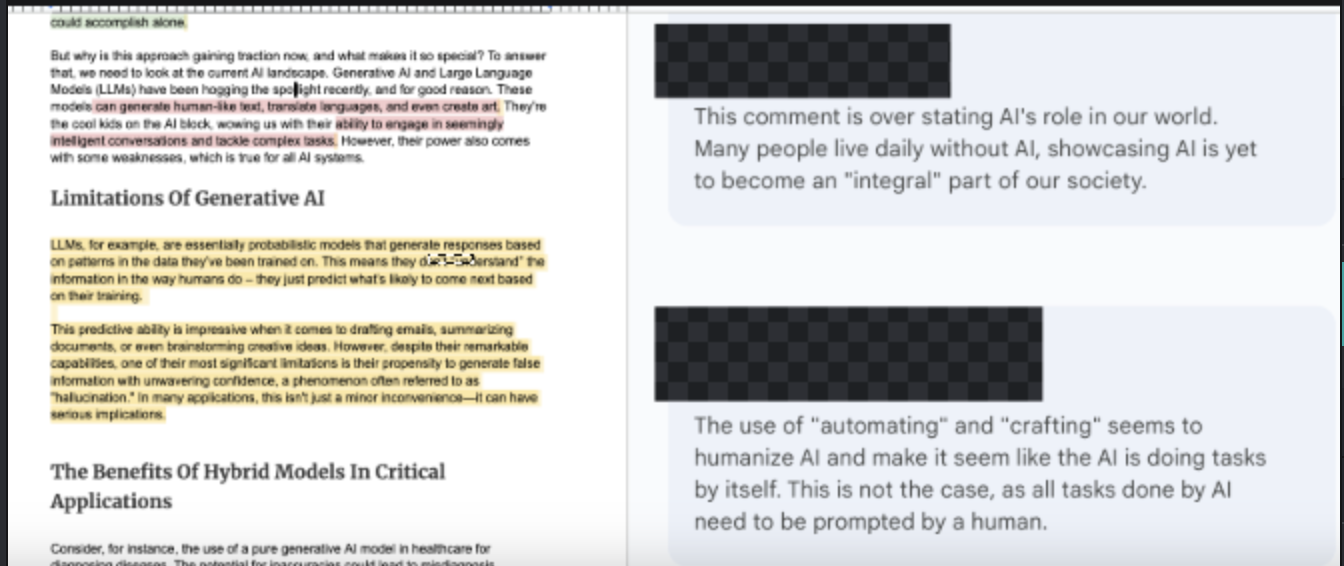
Submission Guidelines
- Before class, at the Course Sandbox, please provide a link to your critical AI literacy exercise.

Creative Challenge #7 – Research Summary – What is the Future of Human Agency?
According to a Pew Research Center study — “The Future of Human Agency” Anderson & Rainie (2022) — the major question confronting humanity with the rise of AI is, “What is the future of human agency?” Trillions of dollars are pouring intro AI research and development. Sam Altman/OpenAI alone is seeking 7 trillion dollars! Research reports by Anderson Consulting, the Boston Consulting Group, and McKinsey suggest a good many jobs will be disappearing in the near future. Thus, this challenge introduces the question of agency — of whether users of GAI (generative artificial intelligence) tools can be “masters of their technology and not its unthinking servants” (NEH).
Researchers are questioning whether generative AI (GAI) may limit writer’s control over their composing and thought processes, and whether, more broadly, these tools will limit human agency, thereby changing what it means to be human. According to a Pew Research Center study — “The Future of Human Agency” Anderson & Rainie (2022), the major question confronting humanity with the rise of AI is, “What is the future of human agency?” The researchers surveyed 540 technology innovators, developers, business and policy leaders, researchers, academics, and activists. They found that 56% of respondents believe AI will limit human agency, expression, and creativity.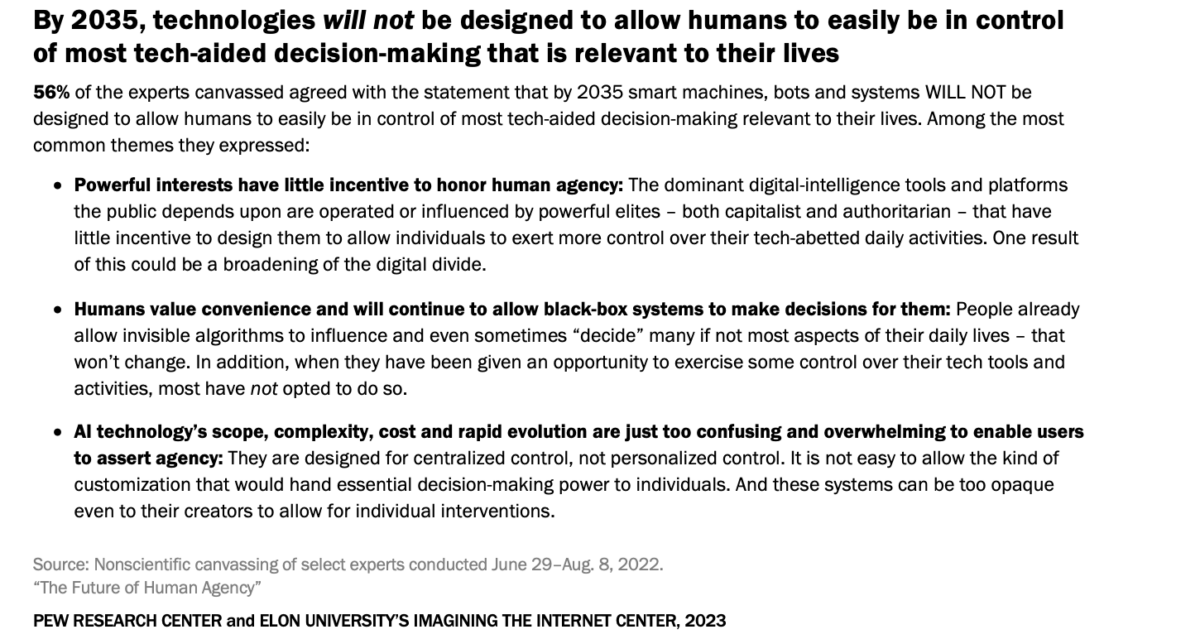
In a more recent study — “Experts Imagine the Impact of Artificial Intelligence by 2040” — Lainie and Anderson (2024) canvased 328 professionals and AI policy experts to learn their opinions about the influence of GAI tools on the future of society. They found these experts were very concerned that “Humanity could be greatly enfeebled by AI” — that AI may diminish human agency and skills. The experts Lainie and Anderson canvassed worry that AI could nearly eliminate critical thinking, reading, decision-making abilities, and healthy in-person connectedness, leading to more mental health problems. Additionally, they fear the impact of mass unemployment on people’s psyches and behaviors due to a loss of identity, structure, and purpose, warning that these factors, combined with a deepening of inequities, may prompt violence.
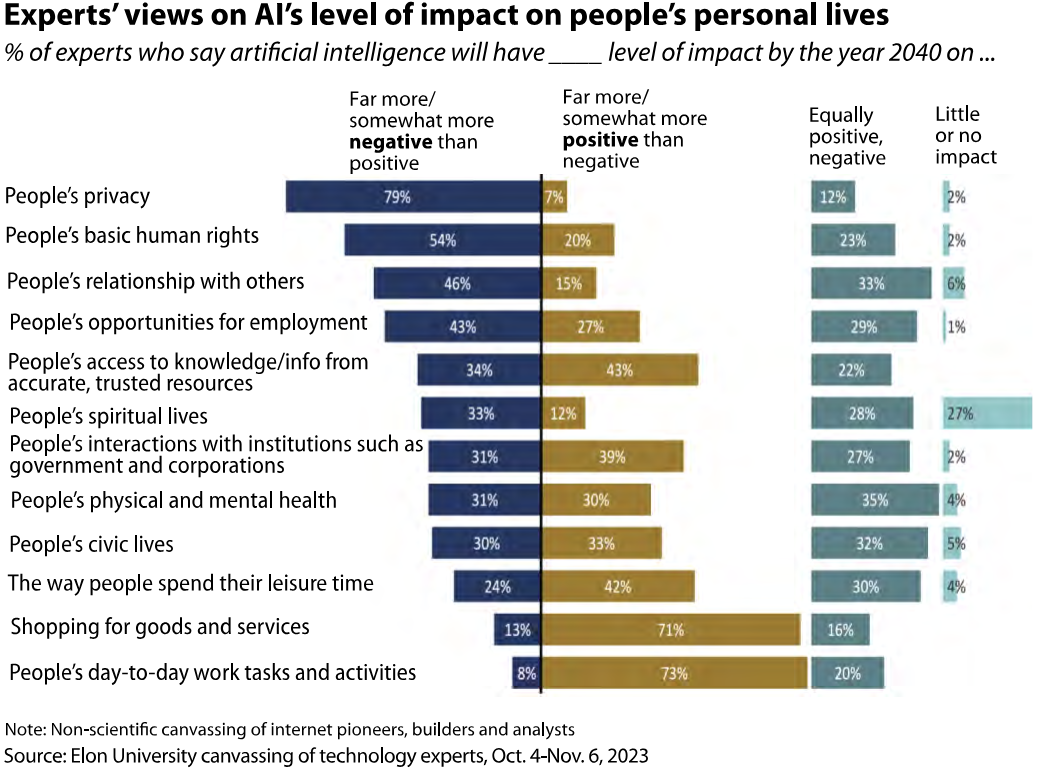
Writing Prompt
Write a 500 word summary of this report: “The Future of Human Agency” Anderson & Rainie (2022). Be sure to download the .pdf of the report in its entirety. Be sure to follow APA 7 citation conventions. At the top of the report, provide the bibliographical information for the report. Your summary should not be evaluative. Instead, try to convey in 500 words the gist of how the researchers engaged in the research — what their methodologies were — and what their primary findings were. If you use quotes, be sure to use quotation marks. As opposed to a 500 word summary, you may also create an infographic on this report.
Submission Guidelines
Upload your summary as a .pdf to Canvas.

Creative Challenge #8 – Deepfakes and DisinformationDeepfakes refer to AI-generated synthetic media that manipulate or create convincing visual and audio content of real people. These technologies use deep learning algorithms to produce face swaps, voice cloning, full body puppetry, and text-to-speech synthesis, mirroring ancient sophistry’s appeals to emotion and tribal loyalties. In today’s knowledge economy, being able to identify deepfakes and other forms of misinformation is a critical AI competency, a basic literacy. Not surprisingly, the MLA CCCC Taskforce on Writing and AI has argued teaching critical AI literacy is crucial for our students and democracy. Thus, this challenges introduces students to research and scholarship on deepfakes, their impact on society, and the importance of understanding and combating misinformation. Students conduct textual research on how AI-generated deepfakes exploit cognitive biases, social dynamics, and information ecosystems. Students critically analyze misinformation, write an annotated bibliography, and create a deepfake or information campaign.
Writing Prompt
This is a two-part assignment:
- Find a deepfake online/misinformation campaign or create a deepfake or misinformation campaign
- Report to your peers on a deepfake/misinformation campaign (either someone else’s or your own). Identify the misinformation and appeals to pathos, confirmation bias, tribalism. Or, create your own deepfake and add a narrative about the discourse community the deepfake addresses and your appeals to pathos,.
What is False Information?
False information, or misinformation, includes any content that is intentionally or unintentionally false, misleading, or deceptive. This can range from completely fabricated news stories to manipulated images and videos designed to mislead viewers. Like deepfakes, the spread of false information can undermine democratic processes, erode public trust, and create social and political instability.
A notable example of misinformation is the Russian interference in the 2016 U.S. Presidential election. Russian operatives created false personas and spread misinformation through social media platforms to influence public opinion and disrupt the electoral process. The Internet Research Agency (IRA), a Russian troll farm, orchestrated a sophisticated campaign that involved creating fake social media profiles, spreading divisive content, and amplifying political discord. They targeted American voters with ads and posts designed to exploit existing social and political tensions, sowing confusion and mistrust.
The IRA’s campaign included false narratives about Hillary Clinton. These narratives involved fabricated emails, fake news articles, and social media posts that painted her as corrupt, dishonest, and involved in various illegal activities. For example, one widely circulated story falsely claimed that Clinton was involved in a child trafficking ring run out of a pizzeria in Washington, D.C., a conspiracy theory known as “Pizzagate.” Although completely baseless, this story gained significant traction, leading to real-world consequences, including a shooting incident at the pizzeria. The Russian misinformation campaign also included efforts to support Donald Trump, whom they perceived as more favorable to Russian interests. The IRA spread content that highlighted Trump’s strengths, amplified his campaign messages, and attacked his opponents. This manipulation of information was intended to sow discord among the American electorate, weaken trust in democratic institutions, and influence the outcome of the election.
During the 2022 Russian invasion of Ukraine, a deep fake video emerged depicting Ukrainian President Volodymyr Zelenskyy appearing to tell Ukrainian soldiers to surrender and lay down their arms. The video was created using AI to superimpose Zelenskyy’s face onto another person’s body and manipulate his voice. Although quickly debunked, this deep fake demonstrated how such technology could be weaponized to spread misinformation and undermine a nation’s resolve during wartime.
Former U.S. President Donald Trump has also been a target and potential source of deep fakes and misinformation. In 2020, a deep fake video surfaced appearing to show Trump calling to have the Republican Party’s leaders arrested. The video was proven to be manipulated using an AI voice cloning tool. Trump himself has also repeatedly shared misinformation, such as falsely claiming the 2020 election was “rigged” due to widespread voter fraud, despite a lack of credible evidence. He continued to push this false narrative even after his recent criminal trial, alleging without proof that the judicial process was also “rigged” against him.
What is a False Information Campaign?
A false information campaign is a coordinated effort to spread misleading or deceptive content to achieve specific objectives, such as influencing public opinion, discrediting opponents, or disrupting societal stability. These campaigns often involve multiple tactics, including creating fake social media accounts, using bots to amplify messages, and leveraging targeted advertising to reach specific audiences.
One of the most infamous false information campaigns involved Cambridge Analytica during the 2016 U.S. Presidential election. Cambridge Analytica, a political consulting firm, harvested data from millions of Facebook users without their consent. This data was then used to create detailed psychological profiles of voters, allowing for highly targeted political advertisements designed to play on voters’ fears, anxieties, and biases to manipulate public opinion. The Cambridge Analytica scandal highlighted the dangers of data misuse and the ethical implications of using personal information to manipulate democratic processes.

In the future once AI systems further simplify deepfakes and the spread of misinformation how can we distinguish fact from fiction And given how large learning models work will AI systems further propagate misinformation thereby undermining social systems democracy and truth Source US Government Increasing Threats of Deepfake Identities Submission Guidelines
Upload your project to Canvas. Be sure to point to urls that are necessary and upload when possible the .pdf version of your narrative.
Final Project
Write a report intended for a business leader in a field you may pursue upon graduation (an accounting, finance, marketing, entrepreneurial firm) that speculates the effects AI may have on the labor and communication practices of that discipline. Your final project should adopt a professional writing style, include at least one visualization, have intext citations and references that match in APA 7, and an annotated bibliography. You are also encouraged to use AI tools for this project, but if you do so be sure to follow the class AI policy. On the last day of class you will be expected to do a one-minute talk with a slide or two on your report findings.
Other Requirements
- Cover Page
- Summary
- Headings and Visuals appropriate for context
- At least five references.
Submission Guidelines
Upload links to your report and presentation to Canvas.
